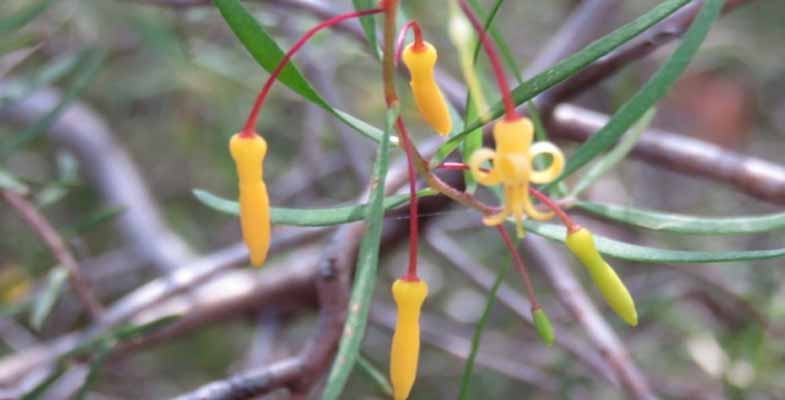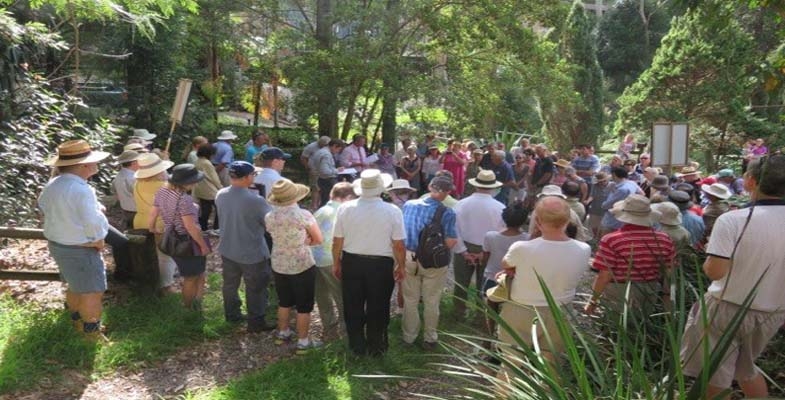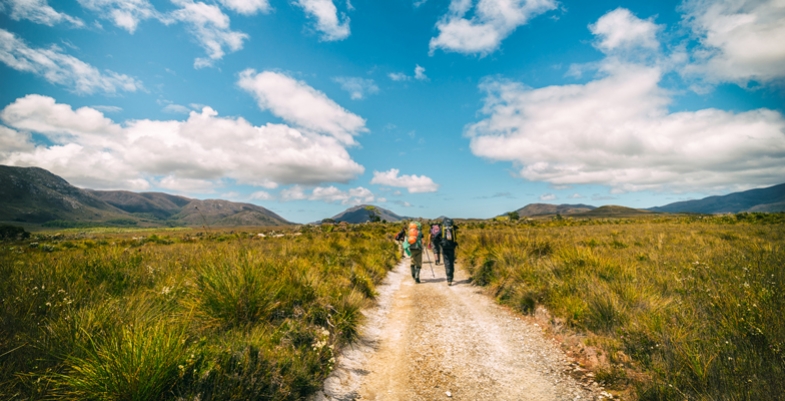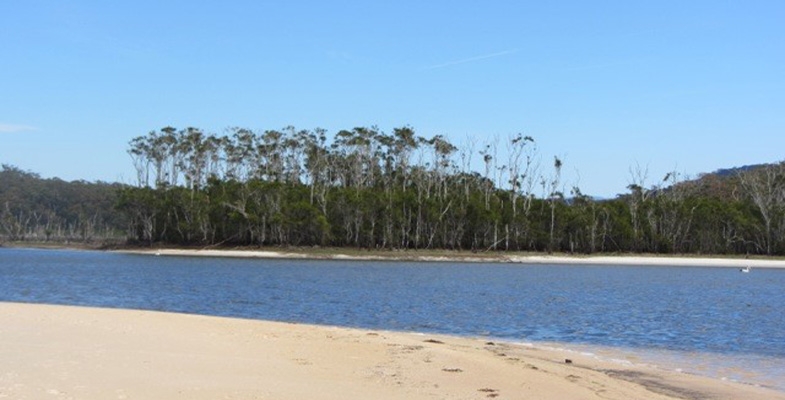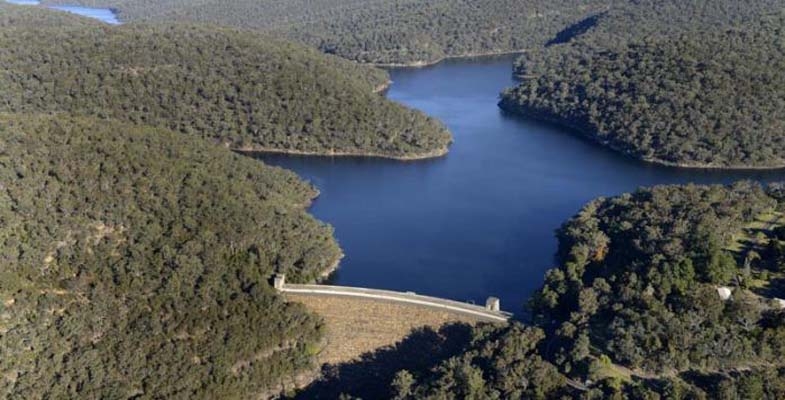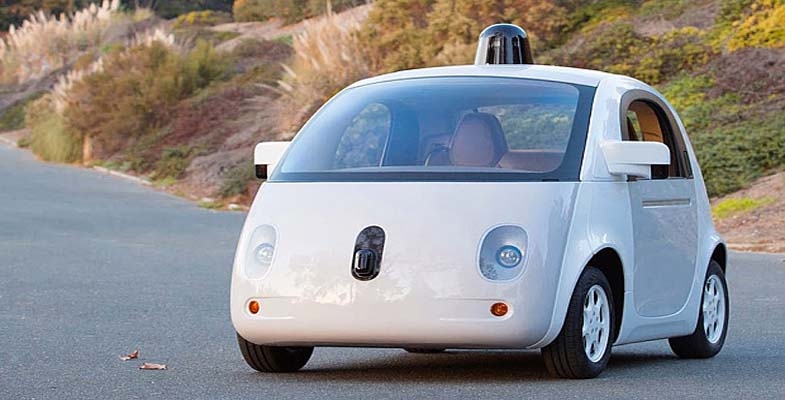STEP Matters 185
Interesting Discovery during Agnes Banks Walk
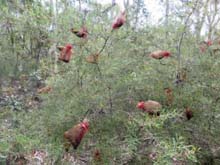 During the STEP walk at Agnes Banks Nature Reserve we came across an endangered Persoonia nutans with lots of little gauze bags tied over the flowers. This is a beautiful delicate plant but it occurs in limited locations. I happened to listen to an episode of ABC Radio National program Off Track that actually described what the bags are all about.
During the STEP walk at Agnes Banks Nature Reserve we came across an endangered Persoonia nutans with lots of little gauze bags tied over the flowers. This is a beautiful delicate plant but it occurs in limited locations. I happened to listen to an episode of ABC Radio National program Off Track that actually described what the bags are all about.
A major population of P. nutans is the one at Agnes Banks, though there are a few others, notably at Castlereagh Nature Reserve and the Georges River area. But all its localities are isolated and have been threatened by past land clearing, sand mining and development.
Currently researchers have difficulty propagating the plant and it has been impossible to germinate the seeds. Research is currently being undertaken by the Australian PlantBank in order to establish a viable emergency genetic supply of seeds. Ideally, if the plant could be propagated, it could be used in habitat restoration and landscaping.
In the radio program, Technical Officer Katharine Catelotti describes the work being done on this plant. Especially intriguing are the seed collection and germination experiments using smoke, heat, fungus and processing through the emu’s digestive tract. As emus are known to eat their scats so they are testing whether the seeds need to go through their system more than one time.
Battle to Preserve the Byles Creek Wildlife Corridor
Beecroft is bearing the brunt of three significant infrastructure developments (North West Rail Link, Epping to Thornleigh Third Track and NorthConnex road tunnel) as well as unit development. These projects have led to the removal of many significant trees including 0.7 hectares of Sydney Turpentine Ironbark Forest which is listed as endangered.
The residents of Malton Road and the Beecroft-Cheltenham Civic Trust have been fighting for many years to save bushland at 79–87 Malton Road from subdivision. If the subdivision application is approved the last remaining corridor of bushland along Byles Creek between Lane Cove National Park and Pennant Hills Park will be lost. It is one branch of Byles Creek that is largely unaffected by urban runoff and it is rare to find such pristine water in urban areas.
The land is in excellent condition, holding high biodiversity values as recognised by its inclusion on Hornsby Shire Council’s Biodiversity Map, with habitat supporting a range of threatened flora and fauna species including Leptospermum deanei, Genoplesium baueri, the grey-headed flying-fox, Powerful Owls and an endangered population of Gang-gang Cockatoos of ‘significant conservation value as it is the last known breeding population of the species in the Sydney metropolitan area’.
If the land is built on, the bushfire regulations will require most of the blocks to be cleared to create asset protection zones. It is unclear whether all six blocks could be built on in any case because of access and asset protection issues. So it could be that most of the area of bushland would be cleared for construction of only two or three houses.
At the June 2015 Hornsby Council meeting following extensive resident addresses and debate, councillors voted unanimously to make a full and comprehensive submission to the NSW Government to acquire this bushland as regional open space. Members of the Byles Creek Valley Union and Civic Trust members worked hard to compile a comprehensive submission to the NSW Government, to augment that prepared by council.
In December the deferred application was refused by council on the grounds that the ecological assessments provided by the applicant were inadequate. Precise confirmation is needed of the possible presence of two plant species: the vulnerable Leptospermum deanei and the endangered Genoplesium baueri, an orchid. It would not be known until March – when the orchid flowers – whether it grows on the site.
The applicant has not been prepared to obtain extra information about this orchid and the applicant then appealed the decision before the Land and Environment Court.
A report commissioned by council by ecological consultant Peter Smith stated the entire site:
… is worthy of purchase and management as a bushland reserve ...
If funding is not available to purchase the land, then further assessment is needed of the impact of the proposed subdivision and residential development of this land …
A patch of bushland like this, with so many large, old trees, forms a crucial piece of habitat for so much of our biodiversity and its loss would be a loss for the community and Sydney as a whole …
He also questioned whether offsets are available in respect of the land to be cleared.
On 10 March a conciliation conference was held on site. Over 100 local residents arrived on a very steamy morning to hear very detailed oral submissions from four local residents explaining their reasons for opposing the application.
Further negotiations are going on via the Land and Environment Court conciliation process. This is due to be finalised on 6 May.
The residents are still fighting with all their might. They are pushing for the proceeds from the council sale of a church hall in Cheltenham to go towards purchasing the land. See www.2119.org.au for the full story. The group has also created a Facebook page for Mikey the Powerful Owl that is frequently seen in the valley.
Please write to the Hornsby councillors to express support for acquiring the land so this precious bushland can be preserved.
Bushwalking Booms as Participation Nearly Doubles
Interesting consumer research has found the number of Australians going bushwalking has risen significantly in the past five years.
Findings from Roy Morgan research shows that between October 2010 and September 2015, the proportion of the population over the age of 14 who reported going bushwalking at least occasionally has almost doubled from 15.6% to 27.3% – a total of 5.3 million Australians. That is a lot of people.
The information was gleaned by a survey conducted by the reputable consumer research organisation, which asked respondents about how often they go bushwalking, and what they did on their last holiday.
Self-reported regular or occasional bushwalkers were shown to be more likely to visit wilderness locations, as well as undertake other outdoor adventures. I got in touch with researchers at Roy Morgan and they kindly provided state specific information that shows South Australia saw the greatest increase in bushwalkers over the period, while Tasmania has the highest rates of participation overall.
Most importantly, it seems the trend towards an increasing interest in bushwalking holds true across the country.
From personal experience, I’ve seen walks near my home in NSW increase in popularity in recent years, with one route in particular jumping from up to 15 walkers on a good Saturday to now closer to 80. There have also been some incredible increases in the number of people on a few specific walks in Royal National Park, but these are big outliers and unsustainable increases rather than the slow and steady growth we might hope for.
This growth is also visible online and in community groups that are closely affiliated with bushwalking. I’ve seen a clear increase in participation in recent years on bushwalk.com and wildwalks.com.
But this seems to be leading to more people presenting as under-prepared for the adventures they’re undertaking. I’ve come across more walkers without an adequate map or relevant details for the route they’re on. This is a worrying trend and I hope that as more experienced members of the bushwalking community we can assist beginners whenever and wherever they need the help. Equipping people new to walking should be a priority, not only for the health and safety of new bushwalkers, but also to try and minimise their impacts on the parks, tracks, flora and fauna they interact with.

What hikers/bushwalkers did on their last trip compared to the average Australian
(from Roy Morgan’s latest findings on the holiday habits of Australians)
Related Industries to Benefit
The overall result of this increase in bushwalking participation will have knock-on effects for the businesses that are closely related to the activity, especially for information services such as Wild.
Cafés and other businesses near walking tracks should also enjoy an increase in walkers, which would be a great win for the edge of suburbs. Hopefully the number of people enjoying a day walk will also graduate into multi-day hikes, and they’ll do so with the help of guides and tour operators. This is the good news Roy Morgan Research wants to communicate, with group account director, Angela Smith saying the apparent boom in bushwalking represents ‘a wonderful opportunity for savvy tourism operators and destination marketers’
‘Not surprisingly, destinations offering scenic wilderness hold greater appeal for hikers and bushwalkers than for the average Australian considering a holiday. When asked where they’d like to visit, this group showed an above-average preference for unspoiled regions such as Freycinet National Park, the Flinders Ranges, Cradle Mountain and Lord Howe Island,’ she said.
If this graduation process occurs then the adventure-specific retailers and clubs should also start to see a marked increase, but it may be too early to see these effects taking place. Also, given the popularity of online retail and community groups, the benefit to traditional organisations will no doubt be a little muted.
We need to be careful that we don’t love these special places to death. Hopefully the most significant change will be for parks and reserve management, otherwise the increase in participation will have adverse impacts on the environment. In NSW, we have seen some walks become over-the-top popular, going from just a few walkers per day to sometimes as many as 1000. Many of these bushwalkers are inexperienced and not aware of potential risks to themselves and the bush. This is not the norm, but show the impact social media can have in encouraging people to adventure, a lesson and warning.
Keeping Bushwalking on Track
Since we are now talking about nearly 30% of the population participating in bushwalking (more than golf, competitive sports, and cycling) it is time to start doing some solid research.
We need to better understand where people are walking, how they use the track networks, how often they return, walking speed, direction of travel, group sizes and so on. Much of this is easy data to collect and will help in better planning, equipping and promotion.
We can better understand how people are using walking tracks now, I am confident that we can plan for a future where even more people are walking, where we maintain a sense of wilderness and look after these precious areas. To do this we need to stop making assumptions and get some real data that can inform planning.
Unlike golf and cycling, the cost of entry to bushwalking is much lower for most popular short walking tracks. Gear suppliers have done a wonderful job at producing lightweight gear for experienced walkers. A challenge for the industry will be to find ways to provide products and services of interest to all these new bushwalkers, again the challenge would be made easier if we can better understand how, when and where these people are walking.
In the meantime, at least we know our national pastime is more popular than ever.
Our thanks to Matt McClelland for permission to republish this article. It was published in Wild on 17 February 2016.
Bushwalking Proposal for the Shoalhaven
A group of people living in the Shoalhaven region have seen the potential of the bushwalking boom.
The Shoalhaven region is an ideal area to promote bushwalking. There is a multitude of choices ranging from beach walking to coastal bushland with lovely lagoon views, and inland there are the spectacular Budawangs. Most of the walking possibilities are in national parks such as Morton, Murramarang and Meroo.
There are already many towns, caravan parks and camping areas which provide an extensive choice of accommodation. Strangely the area does not seem to be very well known so it is very quiet outside the warm weather holiday periods.
A proposal has been developed by the recently formed Shoalhaven Bushwalking Advisory Group which has a membership from right across the Shoalhaven and includes Shoalhaven Bushwalkers and Milton National Parks Association. The group represents a wide spectrum of interests including bushwalking, cycling, kayaking and bird watching. The group is united by a desire to protect and preserve the unique natural environment of the Shoalhaven while encouraging minimal impact recreational access to this remarkable area. Former STEP president, Barry Tomkinson is a member of the group.
This proposal outlines an opportunity to develop sustainable walking tourism, thereby promoting the beautiful natural environment as a year-round national and international iconic walks destination.
Walking tourism has the potential to extend the existing peak season and smooth the influx of visitors over the entire year. This has obvious advantages for infrastructure planning but also ensures that local businesses have more predictable revenue throughout the year, rather than the current boom and bust cycle.
Research demonstrates that for every $1 spent establishing and maintaining walking tourism facilities, as much as $600 is generated for the economy of the region.
However, significant evidence exists to indicate that visitor access to bushwalking and other minimal impact visitor experiences is constrained by a lack of readily available information and coordinated visitor support services, and poorly signed and maintained tracks and access points.
The group’s proposal is for a series of iconic walks to be developed and promoted to position Shoalhaven as a national and international walking destination.
The proposal will commence with work to brand, improve facilities and promote the Southern Shoalhaven Coast Walk, a 40 km walk from Narrawallee Inlet to Merry Beach. The project will act as a pilot for a new, collaborative approach to walking tourism development in the Shoalhaven.
Longwall Mining in Sydney’s Water Catchments
The battle continues against coal mining under the water catchments in the Illawarra but there are some hopeful signs that the NSW Government could start to see sense about the environmental damage that is occurring.
Sydney is fortunate to have a pristine water supply on its doorstep. In theory the water catchments are protected as development and agriculture are prohibited. In the Special Areas in the Illawarra catchment anyone entering the land without permission can be fined $44,000. These catchment areas contain bushland and natural systems such as coastal upland swamps that slow water movement and filter the water that flows into dams such as the Avon and Cataract. Many other cities have to pay millions of dollars to operate synthetic filtering systems of their water supply.
Mining has been undertaken in the Illawarra region since the 1880s but in the early days the methods used were pick and shovel and later machinery that took out small sections of the coal seam. The mine ceilings and walls were supported by the bord-and-pillar method. Since the 1960s the technology for longwall mining has been developed that vastly increases the rate of removal of coal and, incidentally, cuts the level of employment significantly.
The coal is removed by a massive machine that shears away the wall beside it whilst hydraulic powered supports hold up the roof. As the coal is removed, the machine supports are moved forward and the roof is collapsed behind them. The areas of rock extracted are 150 to 400 m wide, 4 m high and can extend for several kilometres. When one longwall is completed another is started leaving a rock support of about 50 m in between.
As such a large section of coal is removed the roof above the longwall collapses. Depending on the nature of the rock above, minor cracking can occur in the strata above, but frequently major cracking has occurred right up to the surface. Cracking leads to water leaking from the creeks and wetlands, pollution from the release of excess minerals from the underlying rocks and cliff falls.
Concerned locals have been documenting the damage over the past ten years and have been leading a campaign to raise awareness of the damage and making detailed submissions explaining the concerns about current and future development applications. This group was formalised by the creation of the Protect Sydney’s Water Alliance in 2013, a network of more than 50 community groups from across Sydney, the Illawarra, Southern Highlands and Blue Mountains.
Illawarra Mines
The Illawarra mines all produce coal for steel making. They make up a complex array of cavities under a region that has reliable rainfall and therefore is a significant source of drinking water for Sydney as well the large population of the Wollongong region. The main miners are:
- Wollongong Coal Ltd, listed on the ASX but majority owned by Indian company Jindal Steel and Power, with mines at Russell Vale near Cataract Dam and Wongawilli further south. The Russell Vale mine has run out of approvals. The Wongawilli mine was suspended but the company has now applied to extend its licence and reopen the mine.
- Illawarra Coal owned by South32, a company demerged from BHP that operates the Dendrobium mine near the Avon Dam.
- Peabody Energy operates the Metropolitan mine near the Woronora Dam.
There are two current controversial applications for extension of current mining operations.
Wollongong Coal
In Issue 180 of STEP Matters we wrote about the Planning Assessment Commission’s (PAC) report on the application to develop eight new longwalls. Wollongong Coal failed to convince PAC that it can expand the Russell Vale colliery without causing substantial and irreversible damage to Sydney’s drinking water supply.
As the mining approvals have run out the mine was closed six months ago, and the entire workforce was sacked. But the company seems undaunted and has continued with the expansion application.
The second review of the mine expansion by PAC has just been released and has reinforced the previous opinions. Despite acknowledging the short-term benefits of the project – which includes the provision of 300 jobs for five years, about $23 million in royalties to the NSW Government and $85 million in capital expenditure and other direct and indirect flow-on effects – PAC concluded that:
On the basis of the information provided, the Commission is of the view that the social and economic benefits of the project as currently proposed are most likely outweighed by the magnitude of impacts to the environment.
In particular, PAC identified the risk of water loss, risk to upland swamps, noise impacts on nearby residents, potential hydrogeological impacts and a loss of ecosystem functions.
PAC is not satisfied that the project is consistent with the State Environmental Planning Policy (Sydney Drinking Water Catchment) 2001 that it would have a neutral or beneficial effect on water quality in the catchment area. The magnitude of water loss is uncertain with the projected range from the proponent and Water NSW varying from minimal to 2.6 GL/year. PAC considers this is a high risk situation. Sydney Water has valued the potential water loss at a cost of $23 million over 25 years. The cost of government subsidies are also estimated to be $23 million. The expansion is economic as well as environmental madness.
A separate issue is the financial viability of the company itself.Wollongong Coal currently has no capacity to repay its debts unless it is thrown another financial lifeline by parent Jindal Steel & Power (Australia) Pty Ltd. The company is currently suspended from trading on the Australian Stock Exchange. If the project falls over the company has no capacity to remedy any damage it could cause to the catchment.
Under legislation passed in 2014 in response to ICAC findings the Minister for Resources can deny a mining application if the proponent is not deemed to be ‘fit and proper’. The Environmental Defenders Office has presented a strong portfolio of evidence that Wollongong Coal fails that test. The minister’s response is so far non-committal. This is the first time a decision is being made under this legislation so it may take a while to consider the precedent it may establish.
The final decision is in the hands of the government.
Dendrobium Mine
The Dendrobium Mine was approved in principle by a Planning Assessment Commission in 2001 and significantly expanded in 2012 despite great concern to those watching the significant damage that had already occurred to every swamp that was above an existing longwall.
The company is now applying for a further expansion closer to Avon Dam. Protect Sydney's Water Alliance objected to the expansion for several reasons:
- proven ongoing damage caused by current longwall mining
- failure by the proponent to take any steps to mitigate damage to swamps in previous longwalls
- failure by the proponent to prove that swamps can be rehabilitated or to undertake agreed research in this area
- the Dam Safety Committee clearly states in its submission that no longwall mining should take within 300 m of the full supply level of Avon Dam (the proposed longwalls will be within 250 m of the dam)
- the cumulative Impact of this mining on the catchments over the long term (as per PAC 2016 rejection of Russell Vale expansion)
- the dubious nature of jobs claims and the lack of any evidence that royalties or bond can ever cover the cost of rehabilitation
The closing date for submissions is 15 April. Click here to make a submission.
Metropolitan Mine
This mine was given approval for major expansion in 2009 despite major damage already occurring to the Waratah Rivulet and failed attempts to remediate the cracks using polyurethane resin injections. Peabody Energy is currently in financial straits because of the fall in the coal price. However, it is expected that the company will apply for a further expansion in the near future.
Significance of PACs Wollongong Coal Report
The issues raised in the PACs report apply to all the other mines in the catchment. It is hoped that heed will be taken of the strong opinions of the report when the current expansion plans of the Dendrobium and, possibly, future Wongawilli and Metropolitan mine expansion applications are considered.

Great Barrier Reef in Peril but Adani Mine Approved
At the end of March aerial surveys of more than 500 coral reefs from Cairns to Papua New Guinea revealed that the most pristine sections of the Great Barrier Reef are currently experiencing the worst, mass bleaching event in its history, with the overwhelming majority of reefs (95% has been quoted) being ranked in the most severe bleaching category.
Bleaching is caused by abnormally warm sea temperatures that have been boosted by the El Niño event that commenced in mid-2015 leading to sea surface temperatures more than 1°C above normal. These conditions are predicted to occur more frequently and more severely as greenhouse gas concentrations in the atmosphere increase.
As ocean temperatures have not cooled down yet in the northern section it is too early to tell what the long-term implications of this event will be. This depends on how soon ocean temperatures reduce and the time before another event occurs. Reefs need about ten years to recover.
The Great Barrier Reef has experienced mass coral bleaching events in the past. In 1998, there was a global mass bleaching event where 50% of the reefs on the Great Barrier Reef were affected. During this time, sea temperatures on the Great Barrier Reef were the highest ever recorded. Mass bleaching also occurred in 2002, with 60% of reefs were affected. This was the largest coral bleaching event on record.
In both the 1998 and 2002 events, the vast majority of corals on the reef survived, as sea temperatures came back down again in time for them to recover. About 5% of the Great Barrier Reef’s coral reefs experienced coral die-off in both these events.
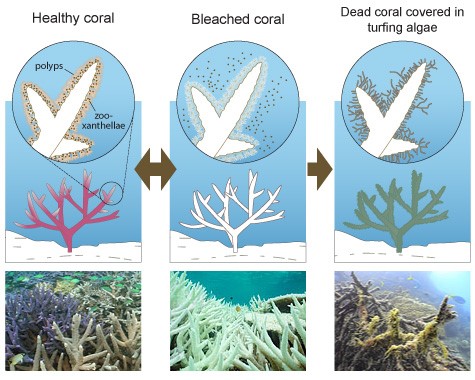 What is Coral Bleaching?
What is Coral Bleaching?
From www.globalcoralbleaching.org
Many types of coral have a special symbiotic relationship with a tiny marine algae (zooxanthellae) that live inside corals’ tissue and are very efficient food producers that provide up to 90% of the energy corals require to grow and reproduce.
Coral bleaching occurs when the relationship between the coral host and zooxanthellae, which give coral much of their colour, breaks down. Without the zooxanthellae, the tissue of the coral animal appears transparent and the coral’s bright white skeleton is revealed. Corals begin to starve once they bleach. While some corals are able to feed themselves, most corals struggle to survive without their zooxanthellae.
If conditions return to normal, corals can regain their zooxanthellae, return to their normal colour and survive. However, this stress is likely to cause decreased coral growth and reproduction, and increased susceptibility to disease. Bleached corals often die if the stress persists. Coral reefs that have high rates of coral death following bleaching can take many years or decades to recover.
Global Coral Bleaching
In 1998, a huge underwater heatwave killed 16% of the corals on reefs around the world. Triggered by the El Niño of that year, it was declared the first major global coral bleaching event. The second global bleaching event that struck was triggered by the El Niño of 2010. The US National Oceanic and Atmospheric Administration announced the third global bleaching event in October 2015 and it has already become the longest event recorded.
The new phenomenon of global coral bleaching events is caused by ocean warming (93% of climate change heat is absorbed by the ocean). Corals are unable to cope with today’s prolonged peaks in temperatures – they simply haven’t been able to adapt to the higher base temperatures of the ocean. Although reefs represent less than 0.1% of the world’s ocean floor, they help support approximately 25% of all marine species. As a result, the livelihoods of 500 million people and income worth over $30 billion are at stake.
What can be done?
A major global bleaching event is considered one of the most visual indicators of climate change. Clearly the current experience demonstrates the importance of taking action to reduce greenhouse emissions. Apart from the potential loss of thousands of jobs in the tourism sector future generations could miss out on experiencing this environmental masterpiece. In the face of this situation the announcement on 3 April by the Queensland Government of the go ahead for the development of the largest coal mine in Australia is hard to fathom.
Adani’s own figures are that the mine and the burning of the mined coal will emit more than 4,600 Mt CO2 over its 90 year lifetime. The Australia Institute has estimated that average annual CO2 emissions will be 79 Mt. Australia’s current annual emissions are around 600 Mt. Many conditions have been placed on the mine and port operation aimed at limiting direct environmental damage but nothing can be done to stop the long-term damage from burning the coal.
There is still some legal action being taken by the local Aboriginal land owners and the Australian Conservation Foundation is taking action based on Australia’s commitments under the world heritage convention, which dictates Australia ‘do all it can to the utmost of its resources to identify, conserve, present and transmit to future generations the outstanding universal value of the Great Barrier Reef world heritage area’ – and that this must be the primary purpose of management of the area.
It says Environment Minister Greg Hunt ‘made an error of law’ by characterising emissions from transport by rail, shipping and then the burning of the Adani coal overseas as ‘not a direct consequence of the proposed action’.
The other hope for stopping the mine is that the falling price of coal will risk the financial viability of the coalmine so that bank finance will be unavailable. Dredging of the port at Abbot Point cannot commence until finance is secured.
Will Driverless Cars be Good for the Environment?
Technological developments have had profound impacts on our lives, some good and some not so good, some with immediate benefits but unforeseen damage in the longer term. The internal combustion engine has transformed our lives from the horse and buggy era to almost total dependence on the use of motor cars.
Motor cars dominate our land use because of the need for roads, parking, service stations, car retailers etc. There is the health cost of fossil fuel particulate emissions and transport is a major contributor to greenhouse gas emissions. There are pollution and social costs from the inefficiencies and stress caused by congestion.
There is currently some debate about the effects of driverless (autonomous) cars. I will leave discussion of the economic effects such as changes in employment to the experts. Here are a few of the arguments for and against driverless cars from the social and environmental point of view. I am interested in hearing your views.
Reduction in Congestion
One of the chief arguments in favour of driverless cars is that they will lead to more efficient use of roads. Driverless cars could communicate with each other and traffic management systems and permit greater numbers of cars to get through a particular stretch of road. This is hypothetical in that it hasn’t been proven with real-world traffic and real driverless cars yet, but it has been well modelled, and there is little reason to doubt that in general this is true.
Driverless cars, it is believed, won’t get in accidents with anything like the frequency or severity of human-driven cars. This will reduce overall congestion, as well as death and injury, personal and financial costs.
Vehicle Efficiency
It is believed that most urban driverless taxis, and perhaps private cars, will be fully electric for reasons that are not primarily environmental.
Electric motors offer safety advantages (they can be used for emergency braking and to some degree for emergency steering). They are also much more durable (an electric motor easily lasts 1 million kilometres), less expensive and less complex than conventional engines. (Currently the reason for the high cost of electric cars is the expense of batteries.) In addition some driverless taxis operating in local traffic, primarily during peak hours, will not need huge battery packs. During idle times they can drive themselves to the next high efficiency charging station as needed.
There can be no doubt that driverless taxis and buses can change the nature of urban mobility. Much more short-distance travel will occur in small, lightweight, extremely energy efficient driverless taxis. Although this may lead to an increase in total miles travelled, the following effects combine to reduce greenhouse gas emissions because driverless taxis will:
- be mostly electric which reduces carbon emissions (provided the electricity comes from renewable sources)
- be smaller and much lighter than the average car which further reduces energy consumption per kilometre
- reduce demand for private cars and the total number of cars and therefore reduce the sizable greenhouse gas emissions during vehicle manufacturing which are typically more than 10% of total life-cycle emissions of a car (according to some estimates, a self-driving car-sharing vehicle or taxi can eliminate seven to ten private cars)
- facilitate multi-modal travel (taking a taxi to the train or bus station, continuing with bus or train)
More Efficient Use of Cars
How will driverless cars change the way we get around? The future may not be in private ownership but in mini-buses and taxis. The response of individuals is hard to predict.
Already there is a trend for people living in inner city areas where there is good public transport to forgo private car ownership. Car sharing services such as GoGet and internet call up services such as Uber are available to meet short-term needs.
Carpooling has been touted for decades as a way to use cars more efficiently. But it never took off because it suffered from an information problem: There was no way to know whether someone living around the corner was heading in the same direction as you, right this instant. It is much easier to drive yourself so many of us head off to work in the same direction with one or two people on board.
At the level of urban design and the environment, driverless cars could produce huge benefits. If cars can drive themselves, fleets of them could scurry around picking people up and dropping them off, working with sleek, robotic efficiency. With perfect computerised knowledge of where potential riders were, they could pick up several people heading the same way, optimising ride-sharing on the fly.
It’s possible that fleets of robocars could become so reliable that many people would choose not to own cars. The reduction in private use of cars could reduce the need for parking. Think of all that land that could be freed up and converted to recreation and green space.
Social Benefits
Driverless cars could enhance the lives of the disabled and older drivers by giving them greater independence although they may still need assistance at either end of their journey.
Questions
The effect of driverless taxis on public transport is not yet clear. There is both the risk that some local trips which are taken by public bus today will migrate to driverless taxis and the opportunity to capture a much larger share of the mobility demands with on-demand buses and mini-buses will not eventuate.
There has been talk of the nirvana of being able to call up your driverless car and, hey presto, your car will appear and take you to work or the shops, take your children to sport or pick them up from the late night party. You will be able to sit in the car and catch up with the work emails or have a snooze. Internet taxis and ride share services cost less because they are more efficient in matching up vehicles and passengers. Costs will become even less if there is no driver to pay. Transport to work will be so enjoyable that people will happily live in the outer suburbs and travel times will not be an inconvenience.
But, just a minute, if one extra person is driven rather than taking public transport won’t lots of people want to do this? Congestion is a non-linear function, so as a road approaches its maximum capacity, small changes in traffic volumes can cause proportionately larger changes in congestion delays. We see this in practice where reduced traffic during school holidays makes a major difference to travelling speeds.
Driverless cars somewhat mitigate this effect, but that doesn’t matter if the use of driverless cars means more cars on the road at the same time. Further, ride shares have to drive further than someone in a private car would in order to pick up their customers or return to their designated drop off points. Completely empty driverless cars on the road are not likely to reduce congestion if more driving is required.
And that’s where the rub is with driverless cars. There are differences of opinion about how driverless cars will actually operate.
Will people stay attached to private cars?
Many people like having cars and use them as handy storage and goods movement facilities. Will they be willing to give up the convenience of having a car immediately on hand? They are status signifiers to neighbours. They are places of privacy. They are cars whose sunk costs are turned into travel conveniences, with weekend trips to the beach and annual holiday trips made economical by having a car for commuting.
While many automotive theorists predict radical changes in human behaviour related to car ownership, there’s little reason to believe that people will become rational just because of a new technology. There may be an impact on private vehicle ownership, but this may not be nearly as big as other advocates suggest. And if this is the case, then there is little reason to expect a reduction in total car miles driven and car ownership.
Will a reduction in family cars increase total mileage driven?
While in general there is little reason to believe that there will be substantial decreases in ownership, let’s explore that model in case it comes true. Let’s identify a model family of mother who works in the city, father who does piece work at home and two children in school. In this model, the family’s single driverless car delivers the mother to work, then swings back and takes the kids to school, then swings back and takes the father to a mid-day yoga class, then unspools this at the end of the day. This does take a two family down to a one car family. Except it does it by up to doubling the total miles driven by the family, as the car goes two ways. Once again, congestion is strongly correlated to total miles driven by cars, and in this model an empty car is driving around with no one in it a lot of the time and the total miles driven by the family vehicle go up. That is likely to increase congestion.
Will parking outside the city centre increase the total distances driven?
Right now people who drive to work park at or very close to work. That’s pretty useful because they have access to their vehicle and it stops driving once they reach their destination. Under one model posited for driverless cars, the car wanders away to cheap parking outside of the core. The problem with this is that it once again puts more vehicle miles on the car which is strongly correlated to increased overall congestion. Imagine a bunch of empty cars on the roads at rush hour trying to get through city streets to cheap parking. And then there is the land required to be allocated for more parking space.
Will longer commutes become viable and so increase the total distance driven?
At present, commuting by car is highly unproductive time. Commuting by public transport is also problematic due to lack of power outlets and Wi-Fi and the inability to have private conversations. There’s a model of the future, however, in which driverless cars provide a private productivity zone, allowing people to live even further from work. Driverless cars promoting suburban living and long commutes increases traffic congestion and fuel use.
Conclusion
Driverless cars have the potential to reduce transport land use, congestion and greenhouse emissions. Do you agree?
References
http://cleantechnica.com/2016/01/17/autonomous-cars-likely-increase-congestion
http://www.driverless-future.com
http://www.newsweek.com/driverless-cars-and-future-parking-418943
http://www.newsweek.com/2016/01/22/driverless-cars-and-future-getting-around-415405.html

